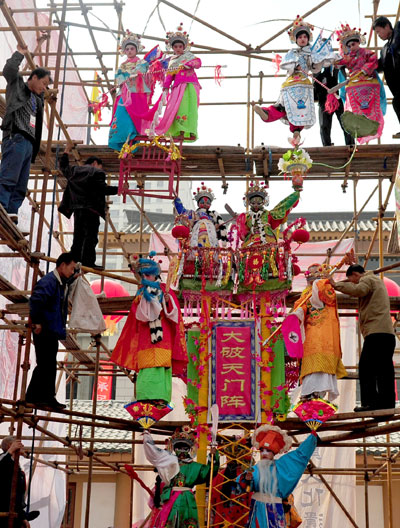A large exhibition and fair showcasing about 50 intangible cultural heritage items opened on Friday in Xi'an, the historic capital of Shaanxi province.
 cription="编辑提供的本地文件" sourcename="本地文件" style="width: 400px; height: 528px" />
cription="编辑提供的本地文件" sourcename="本地文件" style="width: 400px; height: 528px" />
The Third West China's Intangible Cultural Heritage Exhibition and Cultural Industry Fair, part of the ongoing 16th Investment and Trade Forum for Cooperation between East and West China, attracted more than 300 exhibitors of intangible cultural heritage from 12 provinces and autonomous regions in West China.
The event is sponsored by the Ministry of Culture and the Shaanxi provincial government. More than 5,000 pieces of rare cultural relics from some 70 folk museums in more than 20 provinces, municipalities and autonomous regions, including Shandong, Sichuan, Gansu, Inner Mongolia and Ningxia, were also displayed during the exhibition and fair, said Wang Feng'ao, an official with Shaanxi provincial culture department.
Sixty well-known collection agencies from the United States, France and Afghanistan, as well as Chinese provinces and regions including Hong Kong, Macao and Taiwan, attended the exhibition and fair to seek out business opportunities, Wang said.
During the exhibition and fair, business groups from Turkey, South Korea and Japan are also expected to sign investment and cooperation contracts with Xi'an Tang West Market Cultural Industry Investment Co Ltd to build ancient-style blocks in Xi'an.
From April 6 to 8, the Third Development Forum of Private Museums will be held in the Tang West Market Museum, looking at topics including the management of private museums and the expansion of fundraising channels and sources.
The first two intangible cultural heritage exhibitions were held in 2010 and 2011 in the Xi'an Tang West Market, a Tang-style building plaza meant for reproducing and inheriting the tradition and culture of the Tang Dynasty (AD 618-907), considered one of the most prosperous dynasties which had its capital in Xi'an.
The latest cultural promotion is part of the activities of the ongoing trade forum, which attracted about 4,000 foreign businesspeople and more than 200 Fortune 500 corporations, as well as multinational enterprises from more than 50 countries and regions.
The five-day forum looked at expanding foreign exchanges and on strengthening inter-provincial economic cooperation.